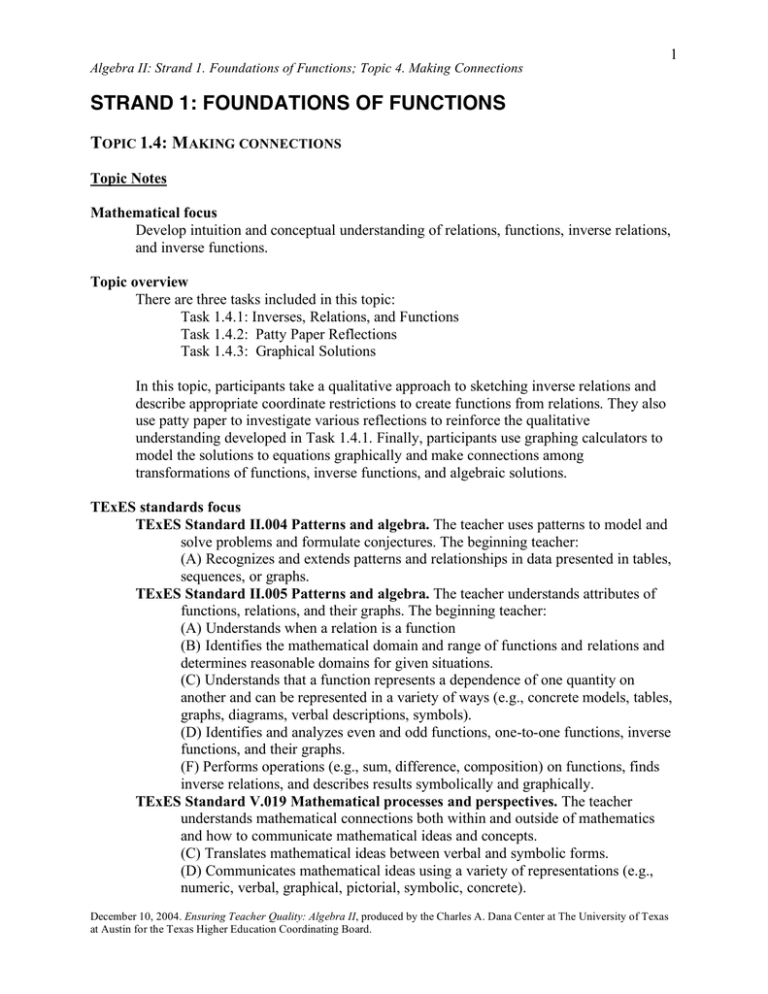STRAND 1: FOUNDATIONS OF FUNCTIONS T 1.4: M
advertisement

Algebra II: Strand 1. Foundations of Functions; Topic 4. Making Connections 1 STRAND 1: FOUNDATIONS OF FUNCTIONS TOPIC 1.4: MAKING CONNECTIONS Topic Notes Mathematical focus Develop intuition and conceptual understanding of relations, functions, inverse relations, and inverse functions. Topic overview There are three tasks included in this topic: Task 1.4.1: Inverses, Relations, and Functions Task 1.4.2: Patty Paper Reflections Task 1.4.3: Graphical Solutions In this topic, participants take a qualitative approach to sketching inverse relations and describe appropriate coordinate restrictions to create functions from relations. They also use patty paper to investigate various reflections to reinforce the qualitative understanding developed in Task 1.4.1. Finally, participants use graphing calculators to model the solutions to equations graphically and make connections among transformations of functions, inverse functions, and algebraic solutions. TExES standards focus TExES Standard II.004 Patterns and algebra. The teacher uses patterns to model and solve problems and formulate conjectures. The beginning teacher: (A) Recognizes and extends patterns and relationships in data presented in tables, sequences, or graphs. TExES Standard II.005 Patterns and algebra. The teacher understands attributes of functions, relations, and their graphs. The beginning teacher: (A) Understands when a relation is a function (B) Identifies the mathematical domain and range of functions and relations and determines reasonable domains for given situations. (C) Understands that a function represents a dependence of one quantity on another and can be represented in a variety of ways (e.g., concrete models, tables, graphs, diagrams, verbal descriptions, symbols). (D) Identifies and analyzes even and odd functions, one-to-one functions, inverse functions, and their graphs. (F) Performs operations (e.g., sum, difference, composition) on functions, finds inverse relations, and describes results symbolically and graphically. TExES Standard V.019 Mathematical processes and perspectives. The teacher understands mathematical connections both within and outside of mathematics and how to communicate mathematical ideas and concepts. (C) Translates mathematical ideas between verbal and symbolic forms. (D) Communicates mathematical ideas using a variety of representations (e.g., numeric, verbal, graphical, pictorial, symbolic, concrete). December 10, 2004. Ensuring Teacher Quality: Algebra II, produced by the Charles A. Dana Center at The University of Texas at Austin for the Texas Higher Education Coordinating Board. 2 Algebra II: Strand 1. Foundations of Functions; Topic 4. Making Connections TEKS/TAKS focus TEKS 2A.2 Foundations for functions. The student understands the importance of the skills required to manipulate symbols in order to solve problems and uses the necessary algebraic skills required to simplify algebraic expressions and solve equations and inequalities in problem situations. TEKS 2A.4 Algebra and geometry. The student connects algebraic and geometric representations of function. The student is expected to: (C) describe and analyze the relationship between a function and its inverse. High School TAKS Objective 1: The student will describe functional relationships in a variety of ways. . High School TAKS Objective 2: The student will demonstrate an understanding of the properties and attributes of functions. Materials Task 1 Graphing calculator Overhead viewscreen calculator Patty Paper Transparencies Transparency pens Markers Large grid chart paper * * * Task 2 * * * * * Task 3 * * * * Procedure When facilitating this topic, consider the following suggestions. After a brief introductory activity and scaffolding provided by the instructor, ask participants to work in groups on Task 1.4.1. Each group will record their findings and report to the class. In Task 1.4.2, participants should work in pairs on transparencies of the activities. Finally, Task 1.4.3 is a prime opportunity to bring together many of the ideas in the foundations strand. Participants should work in groups and report their work. Summary This topic is intended to help move the process of solving equations and finding inverse functions away from symbolic manipulation toward graphical approaches in order to give participants an opportunity to practice or develop an alternative method for teaching the underlying ideas and patterns behind the symbolic manipulation. December 10, 2004. Ensuring Teacher Quality: Algebra II, produced by the Charles A. Dana Center at The University of Texas at Austin for the Texas Higher Education Coordinating Board. 3 Algebra II: Strand 1. Foundations of Functions; Topic 4. Making Connections Extensions This topic could also be approached by introducing parametric equations for graphing functions and relations. The Algebra II/Precalculus TEXTEAMS Institute (pp 108-115) provides an investigation using parametric equations. Assessments Part III of Task 1.4.2 would make a good assessment for Task 1.4.1. Also, at the end of Task 1.4.1 one could ask the following questions. The graph of f is given by the following: Rank the following in order from least to greatest: 0, f (0), f !1 (0),3, f (3), f !1 (3),!2, f (!2), f !1 (!2) Also Part II of Task 1.4.3 would make a good assessment for Part I of Task 1.4.3. Transition to the classroom Which of the tasks are appropriate only for teachers? Which for students? How would we modify a teacher-task to make it student appropriate? Task 1 Task 2 Task 3 Teacher use only * Modify for students Ready for students * * December 10, 2004. Ensuring Teacher Quality: Algebra II, produced by the Charles A. Dana Center at The University of Texas at Austin for the Texas Higher Education Coordinating Board.




